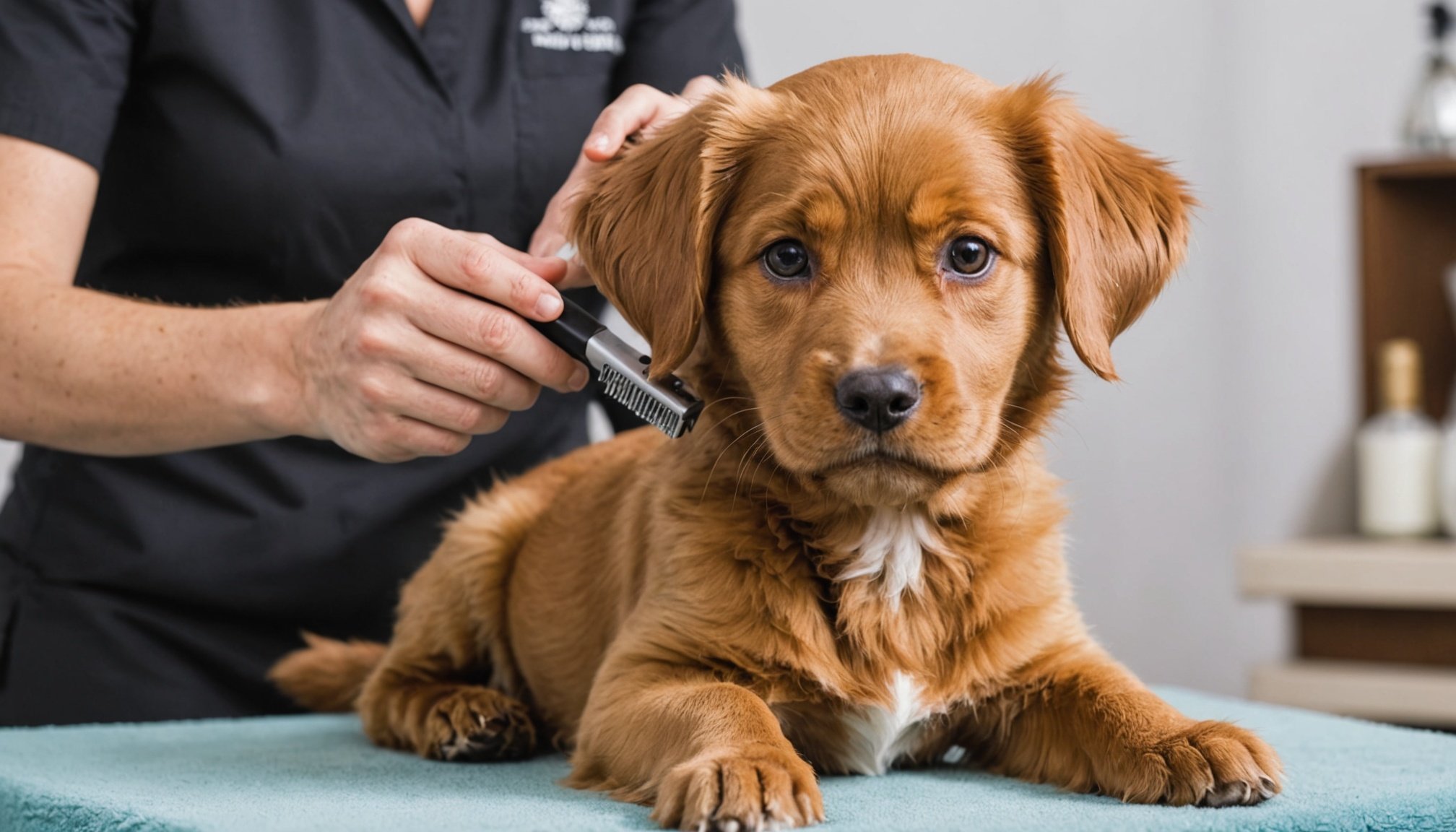Understanding the Basics of Puppy Grooming
Puppy grooming techniques are essential for ensuring the health and well-being of your puppy. Early grooming experiences are crucial because they lay the foundation for a lifetime of healthy grooming habits. Introducing a puppy to grooming at a young age helps them become accustomed to the techniques and tools, reducing anxiety as they grow.
For successful grooming, gather the right grooming essentials. Invest in a quality brush, comb, nail clippers, and a mild puppy shampoo. These tools not only help maintain your puppy’s coat but also ensure their comfort during grooming sessions. A well-groomed puppy not only looks good but is less likely to experience skin irritations and matting.
Also to discover : Ultimate guide to calming your dog amidst fireworks: proven techniques to ease anxiety
Grooming frequency is important to establish early on. Puppies typically require weekly grooming. This allows for maintaining a clean coat, preventing tangles, and checking for any health issues such as skin abnormalities. Adjust the frequency according to your puppy’s breed, coat type, and lifestyle.
Investing time in understanding these basics ensures that grooming becomes an enjoyable and stress-free routine for both you and your puppy, promoting a happier and healthier life together.
In the same genre : Ultimate guide to thriving guppy fish breeding: top tips for success
Creating a Calm Grooming Environment
For successful puppy grooming, establishing a calm grooming environment is crucial. Begin by selecting a quiet, comfortable space free from distractions. A familiar and safe spot can help reduce anxiety in puppies.
Setting the tone with calm grooming techniques can greatly aid in making the experience stress-free. Play soft music or use calming pheromones formulated for dogs to create a soothing atmosphere. Avoid sudden loud noises that might startle your puppy.
When grooming anxious puppies, consider techniques like gentle massage to relax them before starting the grooming session. Speak to your puppy in a calm, reassuring voice, and maintain a gentle touch throughout the process.
Utilizing positive reinforcement during grooming cannot be underestimated. Reward your puppy with treats, praise, or playtime after successful completion of grooming tasks. This associates the grooming experience with positive outcomes, gradually reducing resistance and anxiety over time.
Remember, patience is vital. If your puppy shows signs of stress, such as whining or trembling, give them a break and resume grooming once they’ve calmed down. Being attentive to their comfort ensures grooming becomes a positive experience for both of you.
Step-by-Step Puppy Grooming Procedures
Puppy grooming is an essential part of maintaining your pet’s health and happiness. Breaking it down into specific grooming procedures can simplify the task for pet owners. Here’s a concise guide to mastering puppy grooming.
Bathing the Puppy
To begin, ensure you have all the grooming essentials ready for a smooth bathing process. Use lukewarm water and a puppy-safe shampoo. Wet your puppy’s coat thoroughly, applying shampoo by working it into a lather. Always be gentle, avoiding sensitive areas like the eyes and ears. Rinse well to remove all foam and towel-dry gently.
Brushing Techniques
Brushing is vital for eliminating tangles and mats, which keeps your puppy’s coat healthy. The type of brush depends on your puppy’s coat; for example, a slicker brush works well for long-haired breeds. Start gently from the head, working towards the tail, ensuring all tangles are detangled. Daily practice accustoms your puppy to brushing.
Nail Trimming Procedures
Keeping nails neatly trimmed is crucial. Prior to clipping, get your puppy comfortable by touching its paws regularly. Use nail clippers designed for puppies and trim just the tip—avoid the quick to prevent discomfort. Trim nails regularly to maintain optimal length without causing stress.
Handling Nervous or Anxious Puppies
When dealing with a nervous puppy, recognizing signs of stress is crucial. Watch for behaviours like whining, trembling, or avoiding eye contact. A puppy displaying these signs needs gentle handling to reduce grooming anxiety. The SQuAD approach emphasises precision: handle your puppy with understanding and patience, gradually building their comfort towards grooming.
Introducing grooming gradually can help alleviate anxiety. Begin by associating grooming tools with positive experiences, using them without grooming initially. Rewarding with treats or gentle petting reinforces a sense of security. Over time, shape the puppy’s response by incorporating brief grooming sessions, slowly increasing duration as comfort grows.
Patience and persistence play key roles in desensitizing puppies. Regular, short exposures to grooming environments and procedures can acclimate the puppy, fostering a routine that feels safe. Offering positive reinforcement after each session encourages a smooth transition into a full grooming routine.
Utilising these techniques, the puppy gradually learns to trust the grooming process, paving the way for stress-free sessions. A consistent approach tailored to your puppy’s unique reactions can transform their grooming experience, ensuring an enjoyable and calming activity for both you and your furry friend.
Eco-Friendly Grooming Products
Adopting sustainable grooming products is beneficial for both your puppy’s health and the environment. Eco-friendly options often utilise natural ingredients, minimising chemical exposure, which is crucial for a puppy’s sensitive skin. Moreover, such products are typically biodegradable, reducing the environmental impact associated with traditional grooming products.
When selecting puppy-safe shampoos, carefully examine the ingredient list. Avoid artificial fragrances, dyes, and parabens, as these can irritate a puppy’s delicate skin. Instead, opt for shampoos enriched with natural oils such as aloe vera or chamomile, known for their soothing properties. Conditioners containing oatmeal or shea butter offer moisturising benefits, contributing to a healthy and shiny coat.
Choosing biodegradable shampoos and conditioners is a responsible step towards eco-friendliness. These products break down more rapidly and safely in the environment compared to conventional alternatives. Brands prioritising sustainability often highlight these aspects, making it easier to identify such products.
By integrating eco-friendly products into your puppy’s grooming routine, you support an environmentally conscious approach while ensuring your pet’s safety and comfort. This choice reflects a commitment to holistic care, encompassing both pet well-being and environmental stewardship.
Case Studies and Testimonials
Real-life experiences often shed light on the transformative effects of consistent puppy grooming routines. Owners frequently share how their once anxious puppies have transitioned into relaxed pets through regular grooming sessions.
Consider the story of Max, a young Golden Retriever whose grooming journey transformed significantly over a few months. Initially, Max experienced significant grooming anxiety, often trembling at the sight of brushes and clippers. His owner gradually introduced calm grooming techniques, associating each tool with positive reinforcement, such as treats and affection. Over time, Max began to associate grooming sessions with comfort and predictability, resulting in a calmer, stress-free demeanor during grooming.
Another testimonial comes from Daisy, a spirited Beagle who detested nail trims. Her owners focused on grooming essentials, introducing her to nail clippers without trimming initially. Each session ended with a gentle touch and a reward, slowly easing her discomfort. With patience and persistence, Daisy’s acceptance of grooming improved.
Such grooming success stories underscore the importance of consistent grooming practices. For worried pet owners, these accounts serve as heartening reminders that the right techniques can lead to comfortable grooming experiences, enhancing both the owner’s and the puppy’s well-being.



